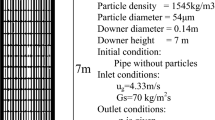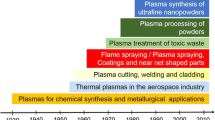Abstract
Thermal plasma processing involves complex interactions of particulates with plasmas. In previous studies (see Parts I and II of this series), an assessment of different effects has been made considering the dynamics and heat and mass transfer of a single particle immersed into a thermal plasma. The last paper of this sequence is concerned with the simulation of thermal plasma jet reactors and the effects caused by multiparticle injection.
A mathematical model is proposed for the simulation of thermal plasma jet reactors, including the mixing phenomena between the jet and the surrounding gases by generalizing the governing equations for simple mixing flows. Also included is the density fluctuation effect by extending the K-ɛ model to a four-equation turbulence model combined with a probability density function. This model is internally consistent covering additional physical phenomena which are not covered by existing models. Unfortunately, its expected higher accuracy cannot be proven because of the present uncertainties associated with the input.
For multiparticle injection, the simulation repeats calculations for single-particle injection, but with different initial conditions correcting the solutions by considering the coupling effects between particles and the plasma.
The results indicate that (i) thermal plasmas show different mixing behavior in different gases; (ii) the density fluctuation effect is important since it causes large differences between the mass-weighted and unweighted time-averaged temperatures of thermal plasma jets; (iii) coupling effects become important when the particle loading rate exceeds half of the plasma mass flow rate; (iv) there are 16 constraints imposed on the modeling work which have to be considered for establishing a base for comparison with future experimental studies.
Similar content being viewed by others
References
E. Pfender and Y. C. Lee, “Particle Dynamics and Particle Heat and Mass Transfer in Thermal Plasmas. Part I: The Motion of a Single Particle Without Thermal Effects,”Plasma Chem. Plasma Process. 5, 211 (1985).
Y. C. Lee, Y. P. Chyou, and E. Pfender, “Particle Dynamics and Particle Heat and Mass Transfer in Thermal Plasmas. Part II: Particle Heat and Mass Transfer in Thermal Plasmas,”Plasma Chem. Plasma Process. 5, 391 (1985).
E. R. G. Eckert and E. Pfender, “Advances in Plasma Heat Transfer,” inAdvances in Heat Transfer, Vol. 4, Academic Press, New York (1967).
E. Pfender, “Heat Transfer from Thermal Plasmas to Neighboring Walls or Electrodes,”Pure Appl. Chem. 48, 199 (1976).
E. Pfender, “Energy Transport in Thermal Plasmas,”Pure Appl. Chem. 52, 1773 (1980).
C. H. Liu, “Numerical Analysis of the Anode Region of High Intensity Arcs,” Ph.D. Thesis, Department of Mechanical Engineering, University of Minnesota (1977).
H. A. Dinulescu, “Analysis of the Anode Boundary Layer of a High Pressure-High Current Arc,” Ph.D. Thesis, Department of Mechanical Engineering, University of Minnesota (1979).
D. M. Chen, “Analytical Modeling of Two-Temperature Argon Arc Plasma,” Ph.D. Thesis, Department of Mechanical Engineering, University of Minnesota (1980).
K. C. Hsu, “A Self-Consistent Model for the High-Intensity Free-Burning Argon Arc,” Ph.D. Thesis, Department of Mechanical Engineering, University of Minnesota (1982).
A. Mazza, “Studies of an Arc Plasma Reactor for Thermal Plasma Synthesis”, Ph.D. Thesis, Department of Mechanical Engineering, University of Minnesota (1983).
M. I. Boulos, “Flow and Temperature Fields in the Fire-Ball of an Inductively Coupled Plasma,”IEEE Trans. Plasma Sci. PS-4, 28 (1976).
J. McKelliget, J. Szekely, M. Vardelle, and P. Fauchais, “The Temperature and Velocity Fields in a Gas Stream Exiting a Plasma Torch,”Plasma Chem. Plasma Process. 2, 317 (1982).
E. Fleck, Y. C. Lee, and E. Pfender, “A Gas-Shrouded Plasma Spray Torch,” International Symposium on Plasma Chemistry, Vol. 4, 1113 (1985); Eindhoven University of Technology, Eindhoven, The Netherlands.
P. A. Libby and F. A. Williams, “Turbulent Reacting Flows,” Springer-Verlag, New York (1980).
W. P. Jones and J. H. Whitelaw, “Calculation Methods for Reacting Turbulent Flows,”Combust. Sci. Technol. 48, 9 (1982).
J. Mostaghimi and E. Pfender, “Effects of Metallic Vapor on the Properties of an Argon Arc Plasma,”Plasma Chem. Plasma Process. 4, 129 (1984).
B. E. Launder and D. B. Spalding,Mathematical Models of Turbulence, Academic Press, New York (1972).
P. Bradshaw, T. Cebeci, and J. H. Whitelaw,Engineering Calculation Method for Turbulent Flow, Academic Press, New York (1981).
V. A. Golubev, “High-Temperature Turbulent Jets”, inTurbulent Jet of Air, Plasma, and Real Gas, G. N. Abramovich, ed., Consultants Bureau, New York (1969).
M. Ushio, J. Szekely, and C. W. Chang, “Mathematical Modeling of Flow Field and Heat Transfer in High-Current Arc Discharge,”Ironmaking Steelmaking, No. 6, 279 (1981).
B. E. Launder and D. B. Spalding, “The Numerical Computation of Turbulent Flows,”Comput. Method Appl. Mech. Eng. 3, 269 (1974).
B. E. Launder, A. Morse, W. Rodi, and D. B. Spalding, “The Prediction of Free Shear Flow—A Comparison of the Performance of Six Turbulence Models,” NASA SP 321 (1972).
W. Rodi, “The Prediction of Free Turbulent Boundary Layers by Use of Two-Equation Model of Turbulence,” Ph.D. Thesis, University of London (1972).
S. V. Patankar and D. B. Spalding,Heat and Mass Transfer in Boundary Layers, Intertext Books, London (1972).
Y. C. Lee, “Modeling Work in Thermal Plasma Processing,” Ph.D. Thesis, Department of Mechanical Engineering, University of Minnesota (1984).
A. Fabre, “Statistical Equations of Turbulent Gases,” inProblems of Hydrodynamics and Continuum Mechanics, Society for Industrial and Applied Mathematics, Philadelphia (1969), p. 237.
T. Cebeci and A. M. O. Smith,Analysis of Turbulent Boundary Layer, Academic Press, New York (1974).
W. P. Jones, “Models for Turbulent Flows with Variable Density and Combustion,” von Karman Institute Lecture Series, Jan. 15–19, 1979.
G. R. Newman, B. E. Launder, and J. L. Lumley, “Modeling the Behavior of Homogeneous Scalar Turbulence,”J. Fluid Mech. 111, 217 (1981).
S. Elghobashi and B. E. Launder, “Modeling the Dissipation Rate of Temperature Variance in a Thermal Mixing Layer,” 3rd Symposium in Turbulent Shear Flows, 15, 13 (1981).
G. E. Klinzing,Gas-Solid Transport, McGraw-Hill, New York (1981), S. L. Soo, “Gas-Solid Suspensions at High Temperatures,”J. Appl. Phys. 34, 1689 (1963).
G. Rosen, “Method for the Removal of Free Electrons in a Plasma,”Phys. Fluids 5, 737 (1962).
Y. C. Lee, K. C. Hsu, and E. Pfender, “Modeling of Particles Injected into a D.C. Plasma Jet,” Fifth International Symposium on Plasma Chemistry, Vol. 2, Heriot-Watt University, Edinburgh, Scotland (1981), p. 795.
P. Proulx, J. Mostaghimi, and M. Boulos, “Plasma-Particle Interaction Effects in Induction Plasma Modeling under Dense Loading Conditions,” 6th International Symposium on Plasma Chemistry, Montreal, Canada, 1983.
N. S. Surov, “Experimental Investigation of Distribution of Parameters in One-Phase and Two-Phase Subsonic Plasma Jets,”High Temp. 7, 276 (1969).
Author information
Authors and Affiliations
Rights and permissions
About this article
Cite this article
Lee, Y.C., Pfender, E. Particle dynamics and particle heat and mass transfer in thermal plasmas. Part III. Thermal plasma jet reactors and multiparticle injection. Plasma Chem Plasma Process 7, 1–27 (1987). https://doi.org/10.1007/BF01015997
Received:
Revised:
Issue Date:
DOI: https://doi.org/10.1007/BF01015997




